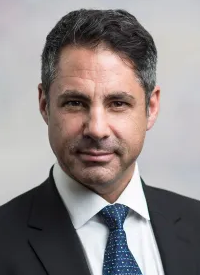Distress in Advanced Cancer May Be Alleviated With Psychedelic-Assisted Psychotherapy
Psychiatric distress and existential distress are associated with poor outcomes in patients with advanced cancers and treatment options such as psychotherapy have demonstrated limited effectiveness.
Stephen Ross, MD

Psychiatric distress and existential distress are associated with poor outcomes in patients with advanced cancers and treatment options such as psychotherapy have demonstrated limited effectiveness, according to Stephen Ross, MD.1
Approximately 30% to 40% of patients with advanced cancers will experience psychiatric distress such as anxiety and depression, but pharmacologic interventions have demonstrated limited effectiveness, Ross noted. He added that up to 50% of patients will experience existential distress including death anxiety and there are no pharmacologic agents approved to combat this.
“[Psychedelics are] a class of drugs that, in terms of their molecular neuropharmacology, all activate their agonis of the serotonin [5-HT]2α receptor [and] if you block this receptor, you obliterate [an individual’s] subjective experiences,” Ross who is director of the NYU Langone Health Psychedelic Medicine Research and Training Program in a presentation during the nursing track at the 40th Annual CFS®. “[These drugs] have effects on the glutamate system and we’re coming to find that it appears they can repair disrupted neurons in the prefrontal cortex and their effects on neuroplasticity through the glutamatergic system is emerging as a potential neurobiological mechanism of action.” Ross added that the effects of psychedelics on dopamine and the adrenergic nervous system are not addictive.
Psychedelics have been used by indigenous peoples for over a thousand years and lysergic acid diethylamide (LSD) was first studied in humans in 1947. Although there were approximately 40,000 participants partaking in 1000 studies conducted between 1950 and 1970 on end-of-life anxiety, addiction, and behavior, “the war on drugs” in the 1960s and association with recreational use restricted the study of psychedelics; agents such as LSD and psilocybin fell under the Controlled Substances Act of 1970.1
However, culture began to shift once more in 1992 when Rick Strassman, MD, pioneered studies on the hallucinogenic tryptamine drug N,N-Dimethyltryptamine (DMT). Additionally, NYU’s Psychedelic Research Group, which was formed in 2006, and several institutions today are researching agents such as psilocybin and LSD for anxiety, depression, as well as addiction. Ross said that Johns Hopkins, UCLA, and NYU are coordinating research on psilocybin.
A crossover NYU study (NCT00957359) evaluating the effects of niacin demonstrated that after treatment with psilocybin plus psychotherapy, patients with advanced cancer had improved quality of life (QOL), reductions in anxiety and depression levels, and meaningful spiritual experiences. The crossover study originally published in 2016 with follow-up data from 2020, demonstrated that 1 day after receiving psilocybin patients (n = 29) experienced reductions in anxiety and depression that endured, suggesting long-term sustained improvements. There was a reduction in existential distress as well as suicidal ideation and improved QOL vs the niacin placebo. Patients were excluded from the study if they had a predisposition to major mental illness.1
“These participants said that these were among the most meaningful, most spiritual experiences of their entire lives,” Ross said. “[They were] very memorable up there with having children and they continued to draw on these profound experiences.” The results suggested that the mystical experience experienced may be a candidate of physiological mechanism of action.
Patients who had stages I, II, III, IV, and other were represented in the study at 17%, 17%, 28%, 34%, and 3%, respectively. Sites of cancer included were breast (31%), reproductive (28%), digestive (17%), lymphoma/leukemia (14%) and other (10%). Additionally, chronic adjustment disorder with anxiety and depressed mood reported was 28%, chronic adjustment disorder with anxiety was 62%, and generalized anxiety disorder was 10%.
The agent had low medical toxicities and was not associated with overdose deaths or organ damage. Ross highlighted that the main harm with the drugs in the psychiatric realm. Adverse events (AEs) reported were mild elevations in blood pressure (76%), headache/migraine (28%), nausea (14%), transient anxiety (17%), and transient psychotic-like symptoms (7%). No serious AEs were reported.
In the follow-up study published in 2020, 16 patients were alive and 15 partook in a self- reported analysis, all reporting sustained reductions in death anxiety, anxiety, and depression. At a follow-up of 4.5 years, 71% of patients (n = 14) said that the psilocybin-assisted therapy was one of the most meaningful and spiritual experiences of their lives.2
In July 2022, NYU received a grant from the National Cancer Institute and National Institutes of Health to launch a phase 2/3 multicenter trial on psychedelic assisted therapy for 200 patients with advanced staged cancer. The trial will occur at the Bellevue Cancer Institute with an aim to increase diversity as the 2016 NYU study included many Caucasian (90%) women (62%) in the study population.
Psilocybin is primarily made synthetically under good manufacturing practice standards that are governed by the FDA, but select companies extract psilocybin, which is the main psychoactive ingredient, from psilocybe mushrooms. Research will be focused on the mechanism of action relating to psilocybin’s neurobiological effects and physiological constructs that may be driving therapeutic benefit will be examined as well.
References
- Ross S. Psychedelic-assisted psychotherapy to treat psychiatric and existential distress in advanced cancer. Presented at: 40th CFS®; November 9-11, 2022; New York, NY.
- Agin-Liebes GI, Malone T, Yalch MM, et al. Long-term follow-up of psilocybin-assisted psychotherapy for psychiatric and existential distress in patients with life-threatening cancer. J Psychopharmacol. 2020;34(2):155-166. doi:10.1177/0269881119897615


